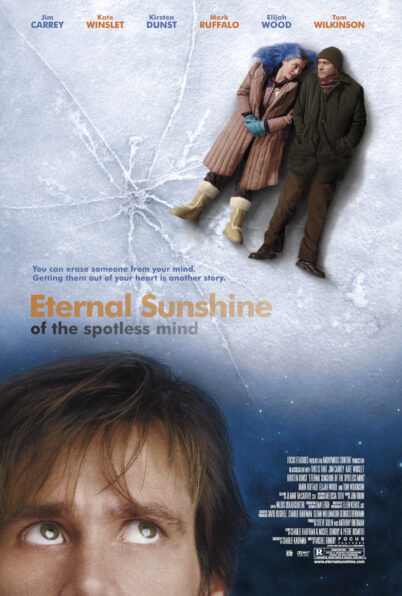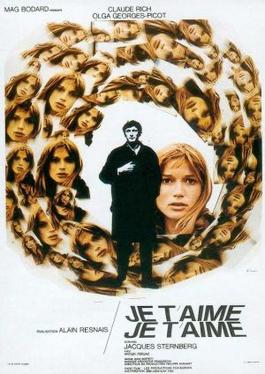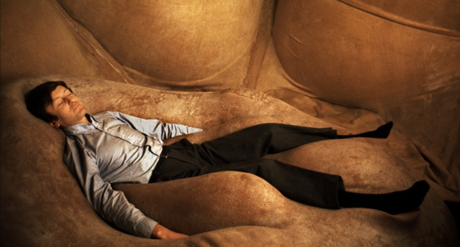Was the US arthouse hit ETERNAL SUNSHINE OF THE SPOTLESS MIND (2004) directly inspired by JE T’AIME JE T’AIME (1968)? If so the creators of ETERNAL SUNSHINE…, namely screenwriter Charlie Kaufman and director Michel Gondry (who also gets a “Story by” credit), have kept quiet about it. The two films, however, share undeniable similarities.
The French-made JE T’AIME JE T’AIME is a science fiction mindbender that like ETERNAL SUNSHINE… was the product of two very distinct visionaries: screenwriter Jacques Sternberg and director Alain Resnais. The latter was following up a string of international hits, including HIROSHIMA MON AMOUR (1959), LAST YEAR AT MARIENBAD (L’Année dernière à Marienbad; 1961) and MURIEL (1963), yet JE T’AIME… failed to match their success.
The film’s bad fortunes began with its scheduled premiere at the 1968 Cannes Film Festival, which was cancelled due to protests, and continued with its subsequent commercial release, which was a disaster that nearly ended Resnais’ career. He wouldn’t make another film for five years (many Americans cling to the belief that French filmmakers aren’t affected by box office takings, which is far from accurate).
Resnais had chosen to collaborate with strong writers for his previous films (Maguerite Duras on HIROSHIMA MON AMOUR, Alain-Robbe Grillet on LAST YEAR AT MARIENBAD, Jean Cayrol on MURIEL), and his initial choice for scripter of JE T’AIME JE T’AIME was Chris Marker (who’d already made one of the seminal French science fiction films, 1962’s LA JETTE). Marker, however, suggested hiring Sternberg in his place, resulting in one of the strongest writer-director collaborations in Resnais’ oeuvre.
The film concerns a time travel experiment conducted on Claude (Claude Rich), a working stiff who attempted suicide. The experiment, which takes place inside a strange pumpkin-like structure, purports to allow Claude to relive a minute from his past that took place during a tropical vacation. But something goes wrong, and Claude ends up experiencing a flood of memories that span the years 1951-68, while back in the here-and-now the scientists conducting the experiment desperately try and recapture his consciousness.
The memories, involving Claude going about his duties as a lowly shipping clerk and cavorting with his terminally ill mistress (Olga Georges-Picot), who he may or may not have killed, are presented out of chronological order. The film is, in essence, a game played by Resnais and Sternberg, who show a portion of one memory and then continue it at a later point, or repeat it in a subtly altered fashion. Claude’s memories, it seems, are affected by the experiment, and increasingly begin to run together or become corroded, with the viewer left on his/her own to discern what’s “real” and what isn’t.
The effect is antithetical to that of LAST YEAR AT MARIENBAD, which offered up a more standard art film stew of enigmas (and sumptuous widescreen images that are likewise absent from JE T’AIME…, which contains a much less extravagant pictorial palette in which the main character is placed in the center of nearly every frame). Viewers of that film were free to create their own interpretations, something that isn’t possible with JE T’AIME…, which has a narrative that’s as precise as it is enigmatic (a likely reason audiences were repelled). For those up to the challenge it’s a fascinating and unprecedented viewing experience, with a concept that was entirely unique–until, that is, the year 2004.
Charlie Kaufman had by then attained legendary status in film circles due to his audacious screenplays for the Spike Jonze films BEING JOHN MALKOVICH (1999) and ADAPTATION (2002). The longtime commercial and music video specialist Michel Gondry made his feature directorial debut was the 2001 Kaufman scripted indie HUMAN NATURE, which suffered from an overly bland and conservative treatment. That was remedied in ETERNAL SUNSHINE…, whose aggressively naturalistic veneer intensifies the surreality of Kaufman’s script (a style Gondry maintained in later features like THE SCIENCE OF SLEEP and MOOD INDIGO).
It stars Jim Carrey in one of his early attempts at ditching his comedy roots. He plays Joel Barish, a meek fellow who after learning that his flighty GF Clementine (Kate Winslet) has had him erased from her memory decides to reciprocate. The majority of the film is taken up with the erasing process, in which the debt to JE T’AIME… (and Resnais’ later film PROVIDENCE) is made clear. During the process Joel decides he doesn’t want Clementine out of his mind, leading to some nutty complications as he finds himself reliving select events from his life and the timestream becomes increasingly corroded.
In the outside world, meanwhile, a pair of techies played by Elijah Wood and Mark Ruffalo, like their counterparts in Resnais’ film, use computers to try and locate Joel’s consciousness. Clementine is stalked by Wood, who’s consciously emulating Joel’s moves, while Kirsten Dunst, playing the company receptionist, discovers she has a disquieting connection to the erasing process. All this is funny, well-acted and thought-provoking, but does it equate with the hallucinatory brilliance of JE T’AIME…?
I say nay. As stylish and artfully bizarre as ETERNAL SUNSHINE… is, it feels like a cartoon when compared to JE T’AIME…, which offers a far more resonant memory-based phantasmagoria. Resnais filmmaking is more subtle and ingenious than Gondry’s easily digestible approach; JE T’AIME… has a core of real pain and disillusionment, whereas ETERNAL SUNSHINE… never digs very deeply, being about, essentially, two people learning to put up with each other.
So in terms of lightweight surreality ETERNAL SUNSHINE OF THE SPOTLESS MIND will suffice. For the real thing, however, presented in all its baffling and uncompromising brilliance, JE T’AIME JE T’AIME is the one and only pick.




